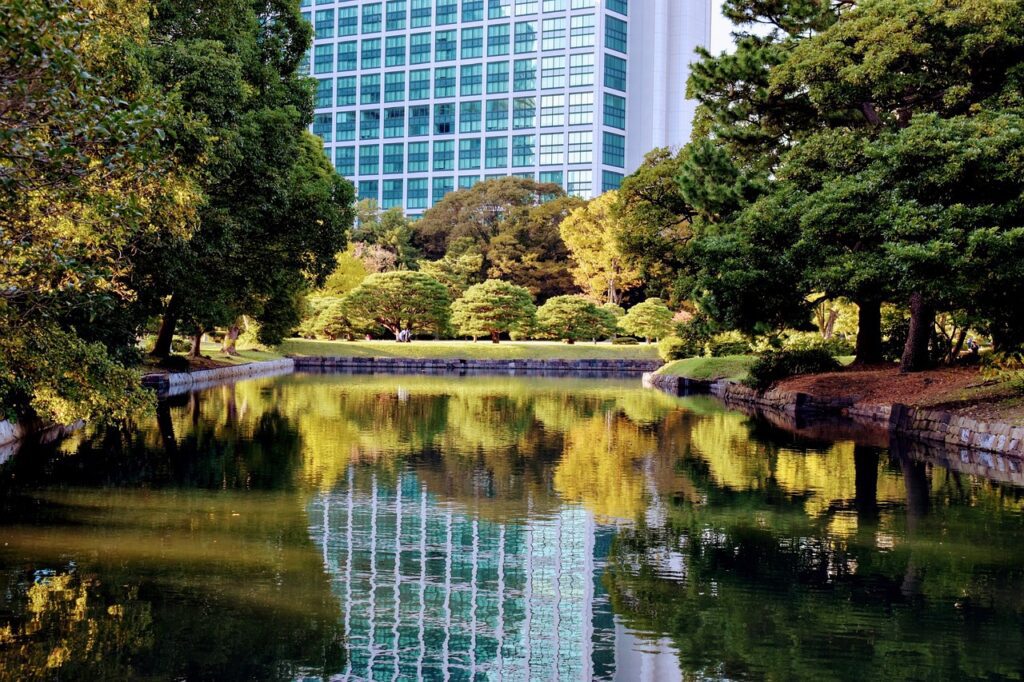Tokyo might be known for its bustling streets and neon lights, but it’s also home to some of the most breathtaking parks and gardens. Whether you’re a nature lover or just in need of a little escape from the urban hustle, Tokyo’s green spaces offer a serene retreat.
From the historic charm of Ueno Park to the meticulously landscaped beauty of Rikugien, there’s something for everyone. Join me as I explore the top parks and gardens in Tokyo that you absolutely can’t miss in 2024.
Overview of Tokyo’s Green Spaces
Tokyo expertly blends its bustling urban life with tranquil green spaces. Many parks and gardens provide residents and visitors a peaceful retreat. These spaces range from large parks like Ueno Park to smaller, intricately designed gardens like Rikugien.
Tokyo boasts a variety of green spaces, each offering unique experiences. Ueno Park, known for its cherry blossoms, houses museums, zoos, and temples. This park offers a chance to experience culture and nature simultaneously. Rikugien, another gem, showcases Edo-period landscape gardening and features a beautiful pond, walking paths, and teahouses.
Other notable parks include Shinjuku Gyoen, a blend of traditional Japanese, French, and English garden styles. This park offers a serene escape in the middle of Shinjuku. Yoyogi Park provides spacious lawns, ponds, and forested areas, perfect for picnics and leisurely strolls.
For those seeking vibrant floral displays, visit Hama-rikyu Gardens. This garden, with its tidal ponds and teahouses, offers a unique contrast between the historic landscape and Tokyo’s skyscrapers. Meanwhile, Kiyosumi Teien, known for its exquisite use of stones and meticulously arranged flora, attracts garden enthusiasts.
These diverse green spaces ensure Tokyo remains a city where nature beautifully complements urban life. Whether for relaxation, cultural immersion, or scenic beauty, Tokyo’s parks and gardens in 2024 promise unforgettable experiences.
Ueno Park
Ueno Park stands out as one of Tokyo’s most celebrated green spaces. It’s renowned for its rich history and captivating attractions, making it a must-visit in 2024.
History and Significance
Ueno Park opened in 1873 as one of Japan’s first public parks. Built on the site of the Kan’ei-ji Temple, the park symbolizes the country’s Meiji-era modernization, blending cultural heritage with nature. It played a pivotal role in Tokyo’s urban development by providing a recreational space for residents and visitors.
Key Attractions
Ueno Park hosts the famous Ueno Zoo, home to over 3,000 animals. The Tokyo National Museum showcases Japanese art and history, while the Tokyo Metropolitan Art Museum houses contemporary works. The park’s Shinobazu Pond, with its lotus flowers and boating facilities, offers scenic charm. Toshogu Shrine adds historical depth, celebrating the Tokugawa Shogunate.
Best Time to Visit
Cherry blossom season in late March to early April is the ideal time to visit Ueno Park. The park’s sakura trees create stunning views and host lively hanami parties. Autumn offers another picturesque period with vibrant foliage from October to early November.
Shinjuku Gyoen National Garden
Shinjuku Gyoen National Garden offers a tranquil retreat from Tokyo’s bustling urban life. This diverse garden features a mix of traditional Japanese, English, and French landscaping styles.
History and Significance
Originally a feudal lord’s residence during the Edo period, Shinjuku Gyoen became an imperial garden in 1906. It opened to the public in 1949. The garden stands out as an important cultural and historical site, embodying over 400 years of garden design traditions. Shinjuku Gyoen also served as a refuge during wartime bombings.
Key Attractions
Visitors can explore several garden styles in one visit. The Japanese Traditional Garden features majestic ponds, bridges, and well-groomed paths, while the English Landscape Garden offers broad lawns and sweeping views. The French Formal Garden boasts meticulously manicured flowerbeds and symmetrical layouts. Other notable spots include the greenhouse, housing exotic tropical plants, and the former imperial rest house.
Best Time to Visit
Cherry blossom season from late March to early April is ideal for vibrant blooms. Autumn, spanning late October to early November, showcases rich foliage colors. Additionally, Shinjuku Gyoen transforms each season, ensuring a unique visit regardless of the time of year.
Rikugien Garden
Rikugien Garden stands out for its Edo-period charm and sophisticated design, making it a must-visit destination in Tokyo. This serene green space offers a perfect retreat from the bustling city life.
History and Significance
Rikugien was completed in 1702, commissioned by Yanagisawa Yoshiyasu, a favored samurai of the fifth shogun Tokugawa Tsunayoshi. It represents the typical Daimyo teien (feudal lord’s garden) of the Edo period. The garden’s name translates to “Six Poems Garden,” reflecting its design based on poems. After changing hands multiple times, Mitsubishi founder Iwasaki Yataro acquired it in 1878. In 1938, his family donated Rikugien to Tokyo, and it’s now a designated Special Place of Scenic Beauty.
Key Attractions
- Tsutsuji no Chaya: A quaint teahouse offering scenic views of the garden.
- Fukiage Chaya: Another charming teahouse built in traditional style.
- Togetsukyo Bridge: This bridge crosses over the central pond, providing photo-worthy views.
- Fujishiro Toge: A hilltop viewpoint offering panoramic views of the garden.
- Takimi no Ido: A quiet waterfall adding to the serene atmosphere.
- Central Pond: The heart of the garden, surrounded by picturesque walking paths.
Best Time to Visit
Rikugien is best visited in late March to early April when cherry blossoms bloom, painting the garden in shades of pink. Another ideal time is mid-November to early December for autumn foliage, transforming Rikugien into a canvas of red and gold. The garden also features evening illuminations during these peak seasons, enhancing its magical ambiance.
Yoyogi Park
Yoyogi Park offers a refreshing retreat with its expansive lawns and wooded areas, making it a favorite among locals and tourists.
History and Significance
Originally a site for the first successful powered aircraft flight in Japan by Captain Yoshitoshi Tokugawa in 1910, Yoyogi Park later served as the Olympic Village for the 1964 Tokyo Olympics. Post-Olympics, it transformed into one of Tokyo’s largest city parks, symbolizing a modern recreational space in the heart of the metropolis.
Key Attractions
- Spacious Open Lawns
The park’s vast lawns invite picnics, leisurely strolls, and various outdoor activities. On weekends, you’ll often see families, joggers, and street performers. - Meiji Jingu Shrine
Adjacent to Yoyogi Park is the historic Meiji Jingu Shrine, dedicated to Emperor Meiji and Empress Shoken. Its serene environment offers a spiritual escape. - Cycling and Jogging Tracks
Well-maintained paths wind through the park, perfect for cyclists and joggers looking to enjoy nature while staying active. - Dog Run Areas
Popular among dog owners, the park has specific areas where dogs can run off-leash, making it a hub for pet enthusiasts. - Yoyogi National Gymnasium
Designed by Kenzo Tange for the 1964 Olympics, this architectural marvel frequently hosts concerts and sporting events.
Best Time to Visit
Visit the park on weekends to experience its lively atmosphere, with cherry blossoms blooming in early April and autumn leaves peaking in late November. Spring brings colorful flower beds, while early summer showcases lush greenery. Special events and festivals, like the annual Yoyogi Park Flea Market, add to the vibrant experience.
Koishikawa Korakuen Garden
Koishikawa Korakuen Garden offers a tranquil escape amid Tokyo’s bustling environment. I relish visiting this garden, renowned for its historical value and beauty.
History and Significance
Established in 1629, Koishikawa Korakuen is one of Tokyo’s oldest and most cherished gardens. Tokugawa Yorifusa, a daimyo, commissioned the garden, and his son, Tokugawa Mitsukuni, completed it. Drawing inspiration from Chinese and Japanese landscapes, the garden’s design reflects a harmonious blend of both influences.
Key Attractions
- Tsutenkyo Bridge: This vibrant red bridge spans a picturesque valley, offering stunning views, especially in autumn.
- Engetsu-kyo Bridge: Known for its unique moon shape reflected in the water, it provides a perfect photo opportunity.
- Inner Garden: This area features intricate ponds, stone arrangements, and charming paths, showcasing classical garden design.
Best Time to Visit
Late November to early December is ideal for autumn foliage, when the garden’s maples turn brilliant shades of red and yellow. Spring, from late March to early April, showcases cherry blossoms, making it another perfect period for a visit.
Hama Rikyu Gardens
Hama Rikyu Gardens provide a scenic escape amidst Tokyo’s bustling cityscape, blending historical elements with natural beauty.
History and Significance
Established in the Edo period, Hama Rikyu Gardens once served as a feudal lord’s residence and duck hunting grounds. The Tokugawa family managed the garden, reflecting the era’s sophisticated landscape design principles. Following the Meiji Restoration, it opened to the public, preserving its historical and cultural essence.
Key Attractions
Notable features include the tidal seawater ponds, which fluctuate with Tokyo Bay’s tides. The traditional teahouse, Nakajima-no-Ochaya, offers matcha tea and seasonal sweets, set within stunning views. Strolling through peony gardens, plum groves, and a 300-year-old pine tree enhances the garden’s charm. The Shioiri Pond with its iconic bridges invites visitors to enjoy the serene atmosphere.
Best Time to Visit
Ideal times to visit are mid-February for plum blossoms and late March to early April for cherry blossoms. Autumn, particularly late November, showcases vivid foliage. Avoid visiting during heavy rains to fully experience the garden’s outdoor beauty.
Kiyosumi Teien
Kiyosumi Teien provides a peaceful retreat in the heart of Tokyo. It’s known for meticulously crafted landscapes and serene ponds.
History and Significance
Kiyosumi Teien dates back to the Edo period. Originally the residence of a wealthy merchant, it was later transformed into a beautiful garden by Iwasaki Yataro, the founder of Mitsubishi. The garden opened to the public in 1932, showcasing the traditional stroll-garden style.
Key Attractions
The garden features an array of scenic spots. Visitors can enjoy the Ryotei Pavilion, the many stone arrangements imported from various regions in Japan, and the vibrant carp swimming in the central pond. The stepping stone pathways encourage leisurely exploration and offer picturesque views from multiple angles.
Best Time to Visit
Kiyosumi Teien is splendid year-round. However, the ideal times to visit are during the cherry blossom season in late March to early April and autumn foliage from late November to early December. The garden’s seasonal colors enhance its natural beauty.
Shiba Park
Shiba Park, one of Japan’s oldest Western-style parks, offers visitors a mix of natural beauty and historical significance. Located in Minato City, it’s known for its panoramic views and proximity to Tokyo Tower.
History and Significance
Shiba Park, established in 1873, exemplifies Japan’s early adaptation of Western park designs. The park’s history dates back to the Meiji era when Tokyo started incorporating Western elements into public spaces. Its strategic location near Zojoji Temple and Tokyo Tower adds historical depth, making it a significant cultural landmark.
Key Attractions
Shiba Park offers several key attractions:
- Tokyo Tower Viewpoints: The park provides stunning views of Tokyo Tower, especially beautiful at night.
- Zojoji Temple: Adjacent to the park, this ancient Buddhist temple contrasts the modern cityscape, offering a spiritual retreat.
- Ginkgo Trees: The avenue of ginkgo trees turns golden in autumn, creating a picturesque setting.
- Momiji-dani: This valley area showcases vibrant autumn foliage and serene walking paths.
Best Time to Visit
The best times to visit Shiba Park are:
- Spring (Late March to Early April): Cherry blossoms bloom, filling the park with pink hues.
- Autumn (Late November): Ginkgo trees and Momiji-dani offer stunning autumn colors, creating a vivid landscape.
Shiba Park combines natural beauty with historical landmarks, making it a must-visit destination in Tokyo.
Conclusion
Exploring Tokyo’s parks and gardens is like stepping into a different world each time. From the historical charm of Rikugien to the vibrant energy of Yoyogi Park there’s something for everyone. Each park offers its own unique blend of natural beauty and cultural significance making them perfect for both relaxation and adventure.
Whether you’re a nature enthusiast or just looking for a peaceful escape from the city’s hustle and bustle Tokyo’s green spaces won’t disappoint. Take the time to visit these stunning locations in 2024 and experience the serene side of this bustling metropolis. Happy exploring!


